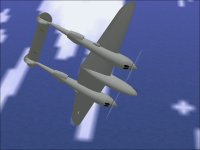The Cowl area was modified over the last few days and along with the Exhaust Plenum and Canopy Frame pretty much concludes the planned modifications to build a P-38F.
The conversion considerably reduced the Parts count in AF99; The F model is at 1127 Parts which is almost 50 below that of the J model.
Most of the difference is in the Coolant Radiators but the Cowl area is also much lower. Both are also much lower in complexity.
One of the most difficult Parts to build was the Intake Opening for the Oil Coolers which needed a lot of adjustment to match the bottom of the Cowl.
- Ivan.
The conversion considerably reduced the Parts count in AF99; The F model is at 1127 Parts which is almost 50 below that of the J model.
Most of the difference is in the Coolant Radiators but the Cowl area is also much lower. Both are also much lower in complexity.
One of the most difficult Parts to build was the Intake Opening for the Oil Coolers which needed a lot of adjustment to match the bottom of the Cowl.
- Ivan.








